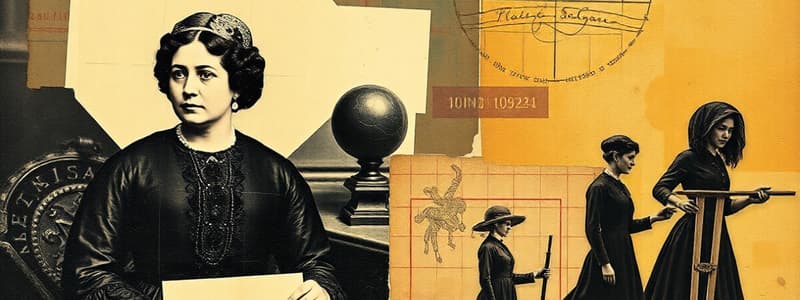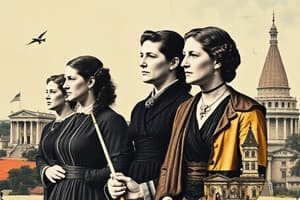Podcast
Questions and Answers
What was a key criticism leveled against suffragists by Elizabeth Cady Stanton?
What was a key criticism leveled against suffragists by Elizabeth Cady Stanton?
- They were too focused on achieving suffrage for women and neglecting other important social issues, such as poverty and education.
- They were not doing enough to educate women about their political rights and responsibilities, hindering their ability to participate effectively in democracy.
- They were failing to adequately address the needs of women in rural areas, leading to a disconnect with their concerns.
- They were too willing to compromise their principles to gain support from groups like immigrants and African Americans. (correct)
The image description of page 2 in the book highlights a key tension within the suffrage movement. What is this tension?
The image description of page 2 in the book highlights a key tension within the suffrage movement. What is this tension?
- The tension between the movement's focus on women's rights and the need to address the broader issues of social justice and equality.
- The tension between the movement's pursuit of suffrage through peaceful activism and the potential for more radical action.
- The tension between enfranchising women and the need for universal suffrage, including the rights of African Americans. (correct)
- The tension between the movement's reliance on white, middle-class women and the need to engage diverse populations.
What does the phrase "Millions of colored WOMEN today Share with colored men THE responsibilities of FREEDOM" suggest about the suffrage movement?
What does the phrase "Millions of colored WOMEN today Share with colored men THE responsibilities of FREEDOM" suggest about the suffrage movement?
- It suggests that the suffrage movement was actively working to address the specific challenges faced by women of color.
- It suggests that the suffrage movement was unified in its support for both women and men of color achieving equality.
- It suggests that the suffrage movement was primarily concerned with achieving equality for white women, even if it meant overlooking the needs of women of color. (correct)
- It suggests that the suffrage movement was willing to exploit the struggle for racial equality in order to gain support for women's suffrage.
The text suggests that suffragists often engaged in what practice to gain support for their cause?
The text suggests that suffragists often engaged in what practice to gain support for their cause?
Which of the following is NOT a group that was excluded from voting rights during the period discussed in the text?
Which of the following is NOT a group that was excluded from voting rights during the period discussed in the text?
Which of these arguments did Mary Ann NOT make to support her belief that black women should have the right to vote?
Which of these arguments did Mary Ann NOT make to support her belief that black women should have the right to vote?
What was Mary Ann's stance on the relationship between the fight for women's suffrage and political parties?
What was Mary Ann's stance on the relationship between the fight for women's suffrage and political parties?
Which statement best reflects Mary Ann's perspective on the responsibilities associated with suffrage for Black women?
Which statement best reflects Mary Ann's perspective on the responsibilities associated with suffrage for Black women?
How did Frances Willard's view of African Americans differ from Mary Ann's?
How did Frances Willard's view of African Americans differ from Mary Ann's?
What challenges did Mary Ann face in both her personal life and her fight for suffrage?
What challenges did Mary Ann face in both her personal life and her fight for suffrage?
Which of Mary Ann's actions demonstrates her unwavering commitment to fighting for suffrage?
Which of Mary Ann's actions demonstrates her unwavering commitment to fighting for suffrage?
What does Mary Ann's question, "Who shall overrule the voice of woman?" suggest about her belief in the power of women's voices?
What does Mary Ann's question, "Who shall overrule the voice of woman?" suggest about her belief in the power of women's voices?
Based on the content, what is the most accurate interpretation of the statement: "Millions of colored women today share with colored men the responsibilities of freedom"?
Based on the content, what is the most accurate interpretation of the statement: "Millions of colored women today share with colored men the responsibilities of freedom"?
What specific event led to Mary Ann Shadd's family moving to Pennsylvania?
What specific event led to Mary Ann Shadd's family moving to Pennsylvania?
How did Mary Ann Shadd challenge social norms in New York City?
How did Mary Ann Shadd challenge social norms in New York City?
What was Mary Ann Shadd's primary motivation for advocating for black people to move to Canada?
What was Mary Ann Shadd's primary motivation for advocating for black people to move to Canada?
What was Mary Ann Shadd's perspective on the role of African Americans in advocating for their own rights?
What was Mary Ann Shadd's perspective on the role of African Americans in advocating for their own rights?
What actions did Mary Ann Shadd take to directly address the Fugitive Slave Act?
What actions did Mary Ann Shadd take to directly address the Fugitive Slave Act?
What is the significance of Frederick Douglass's observation about Mary Ann Shadd's interaction with the trolley driver?
What is the significance of Frederick Douglass's observation about Mary Ann Shadd's interaction with the trolley driver?
Based on the passage, what can be inferred about Mary Ann Shadd's upbringing?
Based on the passage, what can be inferred about Mary Ann Shadd's upbringing?
Why is Mary Ann Shadd described as a "rebel" and an "agitator" in the passage?
Why is Mary Ann Shadd described as a "rebel" and an "agitator" in the passage?
Flashcards
Who was Mary Ann Shadd Cary?
Who was Mary Ann Shadd Cary?
Mary Ann Shadd Cary was a prominent Black journalist, abolitionist, and suffragist who founded "The Provincial Freeman", the first Black newspaper in North America. She was a strong advocate for racial uplift and women's rights, working tirelessly for social justice.
What was "The Provincial Freeman"?
What was "The Provincial Freeman"?
In 1853, Mary Ann Shadd Cary founded "The Provincial Freeman", the first Black newspaper in North America, highlighting her commitment to Black voices and empowering the community.
What did Mary Ann believe about Black empowerment?
What did Mary Ann believe about Black empowerment?
Mary Ann Shadd Cary believed that true progress for the Black community required self-reliance and empowerment. She opposed charity and advocated for Black people to actively work towards their own betterment.
What was Mary Ann's role during the Civil War?
What was Mary Ann's role during the Civil War?
Signup and view all the flashcards
How did Mary Ann fight for women's suffrage?
How did Mary Ann fight for women's suffrage?
Signup and view all the flashcards
What challenges did Mary Ann encounter?
What challenges did Mary Ann encounter?
Signup and view all the flashcards
What was Mary Ann's view on Black women's leadership?
What was Mary Ann's view on Black women's leadership?
Signup and view all the flashcards
Why was the right to vote important to Mary Ann?
Why was the right to vote important to Mary Ann?
Signup and view all the flashcards
Unworthiness of the vote
Unworthiness of the vote
Signup and view all the flashcards
Playing to racist beliefs
Playing to racist beliefs
Signup and view all the flashcards
Blot on the suffragist record
Blot on the suffragist record
Signup and view all the flashcards
Responsibilities of Freedom
Responsibilities of Freedom
Signup and view all the flashcards
Mary Ann Shadd Cary
Mary Ann Shadd Cary
Signup and view all the flashcards
What challenges did Mary Ann face in her early life?
What challenges did Mary Ann face in her early life?
Signup and view all the flashcards
Why did Mary Ann's family move to Pennsylvania?
Why did Mary Ann's family move to Pennsylvania?
Signup and view all the flashcards
What role did Mary Ann's family home play?
What role did Mary Ann's family home play?
Signup and view all the flashcards
Why did Mary Ann become a teacher?
Why did Mary Ann become a teacher?
Signup and view all the flashcards
What was Mary Ann's solution to racial injustice in America?
What was Mary Ann's solution to racial injustice in America?
Signup and view all the flashcards
What was the Fugitive Slave Act?
What was the Fugitive Slave Act?
Signup and view all the flashcards
What was Mary Ann known for?
What was Mary Ann known for?
Signup and view all the flashcards
Study Notes
Mary Ann Shadd Cary
- Known as a "rebel," "mischief maker," and "agitator"
- Frederick Douglass admired her
- Observed her assertive demeanor on a New York City street
- A trolley driver, known for not stopping for African American women, stopped for her
- Child of freed slaves in a middle-class family of 13 children
- Could not attend Delaware schools that only allowed boys to be enrolled
- Moved to Pennsylvania to attend a Quaker School with the family
- Family moved to escape talk about deporting free and enslaved Black people to Africa
- Attended a Quaker school and lived on a farm amongst a growing free Black community
- Became a teacher in Delaware, and other states, after more education
- Became impatient for better lives for her people
- Wrote a letter to Frederick Douglass about the importance of racial progress
- Published her letter in his newspaper, "The North Star"
- Worked for education issues for Black people
- Earned a law degree at Howard University in 1883, the second Black woman in the US to do so
- Believed that moving to Canada, free Black people could prosper
- Started a newspaper for the Black community, called "The Provincial Freeman"
- First African American woman to found a newspaper in North America
- Married Thomas Cary, and had two children
- Worked diligently toward racial uplift, and worked to avoid relying on charity from white people
- Encouraged African American men and women to fight for the Union during the Civil War
- Worked for women's suffrage with Elizabeth Cady Stanton and Susan B. Anthony in Washington, D.C..
- Spoke before the House Judiciary Committee in 1874
- Tried to vote in the 1874 election and was denied because she was Black
- Advocated for women's right to vote and the need for leadership roles for Black women
- Emphasized that education and better lives for Black women would come later, after their right to vote
Studying That Suits You
Use AI to generate personalized quizzes and flashcards to suit your learning preferences.




